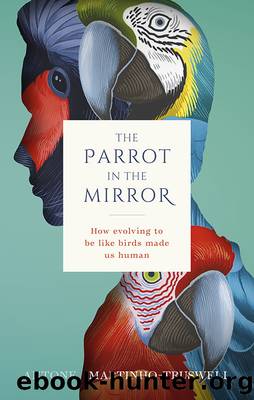The Parrot in the Mirror by Antone Martinho-Truswell

Author:Antone Martinho-Truswell [T. Boothroyd, Andrew]
Language: eng
Format: epub
ISBN: 9780192584984
Publisher: OUP Oxford
Published: 2021-12-27T20:26:39+00:00
Fig. 18 Swans mate for life and both parents help to rear the cygnets. Because the adults only need to attract one mate in their lives, the male does not invest in flashy feathers or bold coloration like a mallard. Lifelong mating, biparental care, and similar-looking sexes tend to occur together and reinforce each other.
This is also related to why we can easily tell apart male and female ducks and turkeys, but not swans or geese. Drakes and male turkeys are colourful, with display feathers that show off how healthy and strong they are. These feathers, with their many pigments and iridescent effects, are not âcheapâ to make: they require a lot of energy for the birdsâ bodies to produce; and they are not âcheapâ to maintain: in the case of the turkey, the maleâs big tail makes escaping predators more difficult, and in the case of the duck, the maleâs bright colours make camouflage almost impossible (especially compared to the dappled brown of the females, which can hide easily in vegetation near rivers and ponds). The malesâ bright colours or long tails are their mating signals to females, saying, âIf I can make this impressive display and keep myself alive while sporting it, you know I am a genetically superior father for your offspring.â The female wants these good genes to contribute to her own offspring so that they will have a better chance of survival, and in the case of her male offspring, a better chance of finding a mate themselves. Seasonally monogamous species, and polygamous species especially, need to invest in these kinds of signals, because they are regularly on the lookout to attract new mates. The duck may have to go out and win a new mate each year, and the turkey has it even harder. A female turkey can only bear one brood per season, and there are about the same number of male and female turkeys. This means that every male turkey that is successful at polygamy, and fathers more than one brood in a season, takes away potential mates from other turkeys. Many males each year will not manage any broods at all. The males need to maintain their flashy tails and bright red wattles to stand a fighting chance at handing on their genes.41
The swans do not have this problem. Once they have found a mate, then, barring catastrophe, they will never need to find another one. It makes no sense to waste resources, or make yourself vulnerable to predators for your whole life in order to sport mating signals that will only be used once. Monogamous species like swans will often attract a mate through rituals instead, like synchronized swimming, head bobbing, singing, or, in the adorable case of mute swans, forming a heart between their gracefully curved necks. As a result, the males and females look more or less identical. This is doubly useful for the males, when you consider that their role of defending the nest during incubation means they need the same ability to hide as their female mate.
Download
This site does not store any files on its server. We only index and link to content provided by other sites. Please contact the content providers to delete copyright contents if any and email us, we'll remove relevant links or contents immediately.
Understandable Statistics. Concepts and Methods by Charles Henry Brase Corrinne Pellillo Brase Jason Dolor James Seibert(161)
Meat Less: The Next Food Revolution by David Julian McClements(153)
ASTROPHYSICS FOR NON-MATHEMATICIANS by Unknown(148)
Modern Physics by Gary N. Felder and Kenny M. Felder(141)
Fundamentals of Physics I by R. Shankar;(139)
Calculus - Single and Multivariable 6th ed. by D. Hughes-Hallett(127)
Sensory Ecology, Behaviour, and Evolution by Stevens Martin;(124)
A Brief Introduction to Classical Mechanics with Illustrative Problems (181 Pages) by Shahen Hacyan(124)
The Parrot in the Mirror by Antone Martinho-Truswell(119)
A History of Mathematical Impossibility by Lützen Jesper;(119)
Practical Math Success in 20 Minutes a Day by Mark A. McKibben(118)
Iraq at the Crossroads by Toby Dodge(111)
Probabilistic Risk Analysis and Bayesian Decision Theory by Marcel van Oijen & Mark Brewer(110)
B. Everitt (ed.) Encyclopedia of Statistics in Behavioral Science by Volume-2(107)
Chemistry for the IB Diploma Third edition by Christopher Talbot Chris Davison(103)
B. Everitt (ed.) Encyclopedia of Statistics in Behavioral Science by Volume-3(102)
Flashes of Brilliance by Ronald L. Holle & Daile Zhang(101)
Ethnobotany by Jose L. Martinez(100)
Principles of Modern Chemistry by David W. Oxtoby H.P. Gillis & Laurie J. Butler(100)
